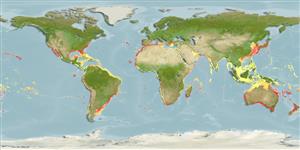Common names from other countries
>
Carangiformes (Jacks) >
Carangidae (Jacks and pompanos) > Caranginae
Etymology: Pseudocaranx: Greek, pseudes = false + French, carangue, the name of a Caribbean fish; 1836 (Ref. 45335).
More on authors: Bloch & Schneider.
Issue
The species Pseudocaranx cheilio (Snyder, 1904) is considered as valid in Eschmeyer (CofF ver. Mar. 2011: Ref. 86697) following Randall (2007: Ref. 86689). The species Pseudocaranx georgianus (Cuvier, 1833) is considered as valid in CofF ver. May. 2011 following Smith-Vaniz & Jelks (2006: Ref. 76781), with Caranx luna Geoffroy Saint-Hilaire, 1817, Caranx platessa Cuvier, 1833, Caranx nobilis Macleay,1881, and Usacaranx archeyi Griffin, 1932 as synonyms. Caranx georgianus (now under Pseudocaranx is also a valid species.
Environment: milieu / climate zone / depth range / distribution range
ນິເວດວິທະຍາ
ສັດທະເລ; ນ້ຳກ່ອຍ ກ່ຽວກັນຫີນ; ລະດັບຄວາມເລິກ 10 - 238 m (Ref. 58302), usually 10 - 25 m (Ref. 5288). Tropical; 40°N - 47°S
Western Atlantic: North Carolina, USA and Bermuda to southern Brazil. Eastern Atlantic: Mediterranean, Azores, Madeira, the Canary Islands, Cape Verde, Ascension and St. Helena Island. Indo-Pacific: South Africa, Japan, Hawaii (Ref. 26145), Australia, Lord Howe and Norfolk islands, New Zealand. Reported from New Caledonia (Ref. 9070).
Length at first maturity / ຂະໜາດ / ນ້ຳໜັກ / Age
Maturity: Lm 34.5, range 28 - 37 cm
Max length : 122 cm TL ຕົວຜູ້/ບໍ່ມີເພດ; (Ref. 4887); common length : 40.0 cm TL ຕົວຜູ້/ບໍ່ມີເພດ; (Ref. 9258); ນ້ຳໜັກສູງສຸດທີ່ເຄຍຈັດພີມມາ: 18.1 kg (Ref. 4887); ອາຍຸສູງສຸດທີ່ເຄຍລາຍງານມາ: 49 ປີ (Ref. 31614)
ຄີ (ໜາມ)ແຂງຢູ່ຫຼັງປາ (ທັງໝົດ) : 9; ຄີຫຼັງຂອງປາ (ຄີອ່ອນ) (ທັງໝົດ) : 25 - 26; ຄີ(ໜາມ) ແຂງຢູ່ຄີກົ້ນປາ
ກຸ່ມປາກະດູກແຂງ
ຄວາມຖີ່ຂອງກຸ່ມຖ່າຍທອດພັນ
ປາທີ່ມີການເຄື່ອນຍ້າຍຈາກທະເລໄປຫານ້ຳຈືດ ແລະນ້ຳຈືດຫາທະເລ
ປາທີ່ມີການເຄື່ອນຍ້າຍຈາກທະເລແລະໄປໄຂ່ຢູ່ນ້ຳຈືດ
ຄີກົ້ນຂອງປາ
ສັດທີ່ມີກະດູກສັນຫັຼງ
ການຖ່າຍທອດທາງກຳມະພັນຈາກພໍ່ແມ່ຫາລູກ: 3; ຄີກົ້ນຂອງປາ: 21 - 22; ສັດທີ່ມີກະດູກສັນຫຼັງ: 25. Greenish blue above, silvery white below; midside of body with yellow stripe; opercle with black spot (Ref. 3197). LL with 20-26 scutes (Ref. 6390). With maxilla the rear edge sloping slightly forward to its main axis, a large, diffuse dark blotch on the operculum, and a lateral line with 57-78 scales in the curved portion and 34-46 posterior scutes (Ref. 33616).
Adults occur in bays and coastal waters, including estuaries (Ref. 9563). Juveniles usually inhabit estuaries, bays and shallow continental shelf waters, while adults form schools near the sea bed on the continental shelf (Ref. 6390). Schools are found at the surface, in mid-water and on the bottom and are often associated with reefs and rough bottom (Ref. 9072). Schools are sometimes mixed with Caranx koheru and Arripis trutta (Ref. 9072). Feed on plankton by ram-filtering and suction feeding and on bottom invertebrates (Ref. 9072, 30206). Eggs are pelagic (Ref. 4233). Cultured only in Japan. (Ref. 4931). One of the best table fish 'being indeed the salmon of St. Helena' (Ref. 5288).
They are usually partial spawners, releasing eggs in small batches at intervals over a period of several weeks (Ref. 27733).
Paxton, J.R., D.F. Hoese, G.R. Allen and J.E. Hanley, 1989. Pisces. Petromyzontidae to Carangidae. Zoological Catalogue of Australia, Vol. 7. Australian Government Publishing Service, Canberra, 665 p. (Ref. 7300)
IUCN Red List Status (Ref. 130435)
CITES (Ref. 128078)
Not Evaluated
Threat to humans
Harmless
Human uses
ການປະມົງ: ເປັນສີນຄ້າ; ການລ້ຽງສັດນ້ຳ: ເປັນສີນຄ້າ; ຊະນິດປາທີ່ຖືກນຳໃຊ້ເຂົ້າໃນການຫາເພື່ອເປັນເກມກິລາ: ແມ່ນ
ເຄື່ອງມື
Special reports
Download XML
ແຫຼ່ງອີນເຕີເນັດ
Estimates based on models
Preferred temperature (Ref.
115969): 15.3 - 25.9, mean 22.3 (based on 362 cells).
Phylogenetic diversity index (Ref.
82804): PD
50 = 0.5625 [Uniqueness, from 0.5 = low to 2.0 = high].
Bayesian length-weight: a=0.01413 (0.00872 - 0.02289), b=2.96 (2.83 - 3.09), in cm Total Length, based on LWR estimates for this species & (Sub)family-body (Ref.
93245).
ຊັ້ນເຂດຮ້ອນ (Ref.
69278): 3.9 ±0.6 se; based on diet studies.
ຄວາມຢືດຢຸ່ນ (Ref.
120179): ຂະໜາດກາງ, ປະຊາກອນຕຳ່ສຸດທີ່ໃຊ້ເວລາສອງເທົ່າ 1.4 - 4.4 ປີ (K=0.18(?); tmax=46(?)).
Prior r = 0.42, 95% CL = 0.28 - 0.63, Based on 1 data-limited stock assessment.
Fishing Vulnerability (Ref.
59153): High to very high vulnerability (73 of 100).
Climate Vulnerability (Ref.
125649): Moderate to high vulnerability (52 of 100).
